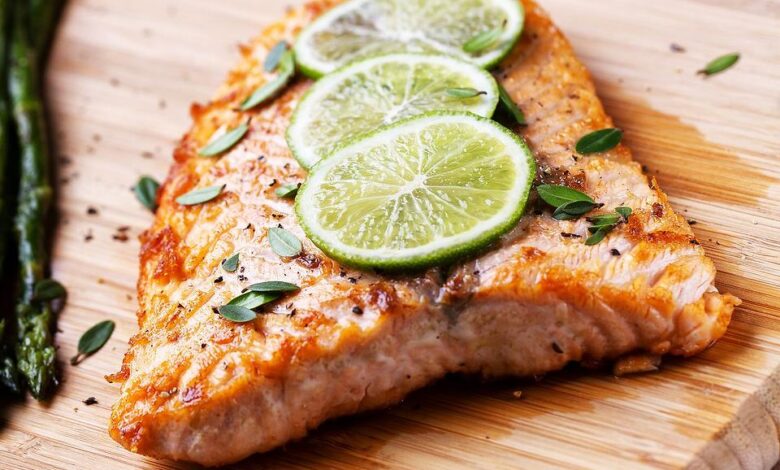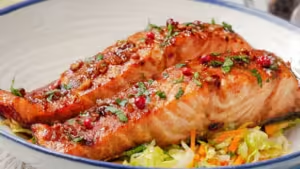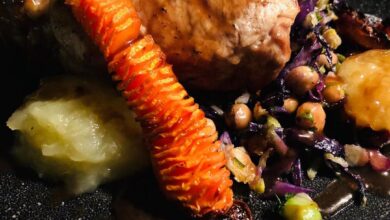Tasty Salmon Recipe
Salmon Recipe

Salmon Recipe Introduction:
Prepare to embark on a culinary journey where simplicity meets sophistication with our tantalizing salmon recipe. Renowned for its rich flavor and delicate texture, salmon is a favorite among seafood enthusiasts and health-conscious food lovers alike.
In this recipe, we showcase the natural beauty of salmon with a harmonious blend of herbs, citrus, and a touch of seasoning that accentuates its inherent flavors. Whether you’re hosting a dinner party or simply treating yourself to a nutritious meal, this dish promises to satisfy both your palate and your senses.
Salmon Recipe Overview:
Prepare to elevate your dining experience with this exquisite salmon recipe that combines simplicity with gourmet flavors. This dish features succulent salmon fillets, seasoned and seared to perfection, complemented by a vibrant citrus and herb sauce.

Salmon Recipe Ingredients:
- Fresh salmon fillets (about 6 Oz each)
- Olive oil
- Salt and pepper
- Fresh herbs (such as dill, parsley, or thyme)
- Lemon or lime wedges for garnish
For the Citrus Herb Sauce:
- Butter
- Garlic, minced
- Fresh lemon juice
- Chicken or vegetable broth
- Capers (optional)
- Salt and pepper to taste
Salmon Recipe Equipment Needed:
- Skillet or frying pan
- Chef’s knife and cutting board
- Wooden spoon or spatula
- Small saucepan
Salmon Recipe Instructions:
- Prepare the Salmon:
- Pat the salmon fillets dry with paper towels and season both sides with salt and pepper.
- Sear the Salmon:
- Heat olive oil in a skillet over medium-high heat. Place the salmon fillets skin side down (if they have skin) and cook for 4-5 minutes until the skin is crispy and golden. Carefully flip and cook for another 3-4 minutes until the salmon is cooked through and flakes easily with a fork.
- Make the Citrus Herb Sauce:
- In a small saucepan, melt butter over medium heat. Add minced garlic and sauté until fragrant, about 1 minute.
- Stir in fresh lemon juice and chicken or vegetable broth. Let the mixture simmer for a few minutes until slightly reduced.
- Optional: Add capers for a briny flavor.
- Season with salt and pepper to taste. Stir in chopped fresh herbs (like dill or parsley) just before serving.
- Serve:
- Plate the seared salmon fillets and spoon the citrus herb sauce over the top.
- Garnish with lemon or lime wedges and additional fresh herbs if desired.
Tips for Success:
- Choosing Salmon: Opt for fresh salmon with firm flesh and a bright, ocean-like aroma. Wild-caught salmon tends to have more flavor than farm-raised varieties.
- Searing Technique: Ensure the skillet is hot before adding the salmon to achieve a crispy skin and even cooking. Avoid overcrowding the pan to allow proper searing.
- Sauce Consistency: Adjust the thickness of the sauce by simmering longer for a thicker consistency or adding more broth for a lighter sauce.
- Garnishing: Fresh lemon or lime wedges add a citrusy brightness to the dish. Additional chopped herbs provide a burst of freshness.
Ingredients:
Salmon Fillets:
- Fresh salmon fillets (about 6 ounces each), preferably skin-on for crispy skin (if desired)
Seasonings:
- Olive oil (for cooking)
- Salt and pepper (to taste)
For the Citrus Herb Sauce:
- Butter (1-2 tablespoons)
- Garlic, minced (2 cloves)
- Fresh lemon juice (from 1 lemon)
- Chicken or vegetable broth (1/2 cup)
- Capers, drained and rinsed (optional, for a briny flavor)
- Salt and pepper (to taste)
- Fresh herbs (such as dill, parsley, or thyme), chopped for garnish
Optional Garnish:
- Lemon wedges (for serving)
- Fresh herbs (for garnish)
Ingredient Tips:
- Choosing Salmon:
- Opt for fresh, wild-caught salmon if available. It tends to have better flavor and texture compared to farm-raised salmon. Look for fillets that are firm with a bright, vibrant color and a mild ocean-like aroma.
- Salmon Fillet Thickness:
- Select salmon fillets that are similar in thickness to ensure even cooking. Thicker fillets may require slightly longer cooking times, while thinner fillets cook more quickly.
- Seasoning:
- Season the salmon generously with salt and pepper on both sides before cooking. This simple seasoning enhances the natural flavors of the fish.
- Olive Oil Quality:
- Use high-quality extra virgin olive oil for cooking the salmon. It adds a subtle fruity flavor and helps achieve a crispy skin when searing.
- Fresh Herbs:
- Incorporate fresh herbs like dill, parsley, or thyme for added freshness and aroma. Chop the herbs finely and sprinkle them over the salmon just before serving for a burst of flavor.
- Citrus Influence:
- Fresh lemon juice adds brightness and acidity to the dish, balancing the richness of the salmon. Use freshly squeezed lemon juice for the best flavor.
- Garlic Enhancement:
- Mince garlic finely to release its flavor into the citrus herb sauce. Saute it briefly in butter before adding other ingredients to develop a savory base for the sauce.
- Capers for Depth:
- Optional capers provide a briny, tangy flavor that complements the richness of the salmon and adds complexity to the citrus herb sauce. Rinse them before adding to reduce their saltiness.
- Broth Selection:
- Choose low-sodium chicken or vegetable broth for the sauce to control the saltiness. It adds depth and richness without overpowering the delicate flavors of the salmon.
- Garnishing:
- Garnish the finished dish with additional lemon wedges and a sprinkle of fresh herbs to enhance presentation and flavor. It adds a final touch of freshness and visual appeal to your salmon recipe.
Equipment Needed:
- Chef’s Knife and Cutting Board:
- Use a sharp chef’s knife for cutting and trimming the salmon fillets, as well as chopping herbs and garlic.
- Skillet or Frying Pan:
- A sturdy skillet or frying pan, preferably non-stick or cast iron, for searing the salmon fillets.
- Tongs or Spatula:
- Tongs are ideal for flipping and handling the salmon fillets while cooking. A spatula can also be used for turning and moving the fillets gently.
- Small Saucepan:
- Required for preparing the citrus herb sauce. This saucepan will be used to melt butter, sauté garlic, and simmer the lemon juice and broth.
- Wooden Spoon or Whisk:
- Use a wooden spoon or whisk for stirring and combining ingredients, especially when making the citrus herb sauce.
- Measuring Spoons and Cups:
- Essential for accurately measuring ingredients like salt, pepper, butter, lemon juice, and broth.
- Citrus Juicer (optional):
- Helpful for extracting fresh lemon juice efficiently. Alternatively, you can use a fork to juice the lemon manually.
- Instant-Read Meat Thermometer:
- Though optional, an instant-read thermometer is useful for checking the internal temperature of the salmon to ensure it’s cooked to perfection (145°F or 63°C for salmon).
- Plate or Serving Dish:
- Prepare a plate or serving dish for plating the cooked salmon fillets and serving them with the citrus herb sauce.
- Optional Equipment:
- Aluminum foil (for tenting the salmon while resting)
- Lemon wedges (for garnish)
- Fresh herbs (such as dill or parsley) for garnish
Step-by-Step Instructions:
Ingredients:
- Fresh salmon fillets (about 6 ounces each)
- Olive oil
- Salt and pepper
- Butter (1-2 tablespoons)
- Garlic, minced (2 cloves)
- Fresh lemon juice (from 1 lemon)
- Chicken or vegetable broth (1/2 cup)
- Capers, drained and rinsed (optional)
- Fresh herbs (such as dill, parsley, or thyme), chopped for garnish
- Lemon wedges, for serving (optional)
Equipment Needed:
- Chef’s knife and cutting board
- Skillet or frying pan
- Tongs or spatula
- Small saucepan
- Wooden spoon or whisk
- Measuring spoons and cups
- Citrus juicer (optional)
- Instant-read meat thermometer (optional)
Step-by-Step Instructions:
- Prepare the Salmon:
- Pat the salmon fillets dry with paper towels to remove excess moisture. Season both sides generously with salt and pepper.
- Heat the Skillet:
- Heat a tablespoon of olive oil in a skillet or frying pan over medium-high heat until hot.
- Sear the Salmon:
- Place the salmon fillets, skin side down (if they have skin), into the hot skillet. Sear for about 4-5 minutes, without moving them, until the skin is crispy and golden brown.
- Flip and Cook:
- Carefully flip the salmon fillets using tongs or a spatula. Cook the other side for another 3-4 minutes, or until the salmon is cooked to your desired doneness. The internal temperature should reach 145°F (63°C) when measured with an instant-read thermometer.
- Make the Citrus Herb Sauce:
- While the salmon is cooking, prepare the citrus herb sauce. In a small saucepan, melt 1-2 tablespoons of butter over medium heat.
- Add minced garlic to the melted butter and sauté for about 1 minute until fragrant.
- Add Lemon Juice and Broth:
- Pour in the fresh lemon juice and chicken or vegetable broth. Stir to combine and bring the mixture to a simmer.
- Simmer the Sauce:
- Let the sauce simmer for a few minutes until it reduces slightly and thickens. This will concentrate the flavors.
- Optional: Add Capers
- If using capers, add them to the sauce during the last minute of simmering. Stir to incorporate them into the sauce.
- Season and Finish:
- Season the sauce with salt and pepper to taste. Stir in chopped fresh herbs (such as dill, parsley, or thyme) just before serving for added freshness.
- Serve:
- Plate the seared salmon fillets and spoon the citrus herb sauce generously over each fillet.
- Garnish with additional fresh herbs and serve with lemon wedges on the side, if desired.
Tips for Success:
- Ensure the skillet is hot before adding the salmon to achieve a crispy skin.
- Use a spatula to carefully flip the salmon to avoid breaking the fillets.
- Adjust the thickness of the sauce by simmering longer for a thicker consistency or adding more broth for a lighter sauce.
- Let the salmon rest for a few minutes before serving to allow the juices to redistribute.
Tips and Tricks:
Preparation Tips:
- Choosing Salmon:
- Opt for fresh salmon if possible. Look for firm, shiny flesh without any strong odor.
- If buying frozen, thaw it properly in the refrigerator overnight before cooking.
- Seasoning:
- Keep it simple with salt, pepper, and a touch of olive oil for basic seasoning.
- Experiment with herbs like dill, thyme, or rosemary for added flavor.
- Marinating (optional):
- Marinades can enhance flavor. A simple marinade with soy sauce, garlic, and lemon juice works well.
- Don’t marinate for too long (30 minutes to 1 hour is usually sufficient) to avoid overpowering the delicate salmon flavor.
Cooking Methods:
- Pan-Seared Salmon:
- Heat a skillet over medium-high heat with a bit of oil.
- Place the salmon skin-side down first (if skin-on) and cook for 4-5 minutes until crispy.
- Flip and cook for an additional 3-4 minutes until the salmon is cooked through but still moist.
- Baked Salmon:
- Preheat oven to 400°F (200°C).
- Place seasoned salmon on a parchment-lined baking sheet.
- Bake for 12-15 minutes until the salmon flakes easily with a fork.
- Grilled Salmon:
- Preheat grill to medium-high heat.
- Brush salmon with oil to prevent sticking.
- Grill for 4-5 minutes per side, depending on thickness, until cooked through.
Tips for Perfect Salmon:
- Cooking Time: Aim for about 10 minutes of cooking time per inch of thickness. The salmon should be opaque and flake easily with a fork.
- Resting: Let the salmon rest for a few minutes after cooking to allow juices to redistribute.
- Internal Temperature: Salmon is safe to eat at 145°F (63°C) internal temperature, measured at the thickest part.
Serving Suggestions:
- Sides: Serve with roasted vegetables, a fresh salad, or steamed rice.
- Sauces: Consider a creamy dill sauce, lemon butter sauce, or a simple squeeze of fresh lemon juice.
- Garnish: Fresh herbs, such as parsley or chives, add a pop of color and flavor.
Serving Suggestions:
1. Side Dishes:
- Roasted Vegetables: Such as asparagus, Brussels sprouts, or carrots. The earthy sweetness of roasted vegetables pairs well with the richness of salmon.
- Steamed Vegetables: Broccoli, green beans, or snap peas. Lightly seasoned with salt and pepper to keep the focus on the salmon.
- Mashed Potatoes: Creamy mashed potatoes provide a comforting contrast to the tender salmon.
- Quinoa or Rice: Serve salmon over a bed of fluffy quinoa or jasmine rice for a wholesome meal.
2. Salads:
- Green Salad: A simple mixed green salad with a light vinaigrette can refresh the palate alongside salmon.
- Cucumber Salad: Thinly sliced cucumbers dressed with vinegar, dill, and a touch of honey offer a crisp, tangy side.
- Caprese Salad: Fresh mozzarella, tomatoes, and basil drizzled with balsamic glaze. The acidity pairs nicely with the salmon.
3. Sauces and Condiments:
- Lemon Dill Sauce: A classic choice that enhances the natural flavors of salmon.
- Hollandaise Sauce: Rich and buttery, perfect for adding a luxurious touch to grilled or poached salmon.
- Soy Ginger Glaze: A savory-sweet glaze made with soy sauce, ginger, garlic, and a touch of honey or brown sugar.
4. Garnishes:
- Fresh Herbs: Sprinkle chopped parsley, dill, or chives over the salmon for a burst of freshness.
- Citrus Slices: Thin slices of lemon or lime can be served alongside the salmon or squeezed over the top for added brightness.
- Toasted Almonds or Sesame Seeds: Add crunch and nuttiness as a final touch.
5. Bread or Rolls:
- Garlic Bread: Serve alongside for a comforting addition.
- Whole Grain Rolls: A healthier option to soak up any extra sauce.
Presentation Tips:
- Plating: Arrange the salmon neatly on the plate, preferably skin-side down if seared, with the side dishes surrounding it attractively.
- Color Contrast: Aim for a variety of colors on the plate to make the meal visually appealing.
- Balance: Consider texture and flavor balance between the salmon and its accompaniments.
FAQs:
1. How do I know when salmon is cooked through?
- Salmon is cooked through when it turns opaque and easily flakes with a fork. You can also use a food thermometer inserted into the thickest part of the salmon; it should read 145°F (63°C).
2. Should I cook salmon with the skin on or off?
- Either way is fine, depending on your preference. Cooking salmon with the skin on helps hold the fish together and can be crispy when seared. If you prefer not to eat the skin, you can easily remove it after cooking.
3. How should I store fresh salmon?
- Store fresh salmon in the coldest part of your refrigerator, ideally on a tray covered with plastic wrap or in an airtight container. Use it within 1-2 days for the best quality.
4. Can I freeze salmon?
- Yes, you can freeze salmon. Wrap it tightly in plastic wrap and then in aluminum foil or place it in a freezer-safe bag. It can be stored in the freezer for up to 3 months. Thaw frozen salmon in the refrigerator overnight before cooking.
5. What are some tips for preventing salmon from sticking to the pan?
- Ensure the skillet is well-heated before adding the salmon. Lightly coat the salmon with oil and place it in the pan skin-side down if it has skin. Avoid moving the salmon too much while cooking; let it develop a crust before flipping.




